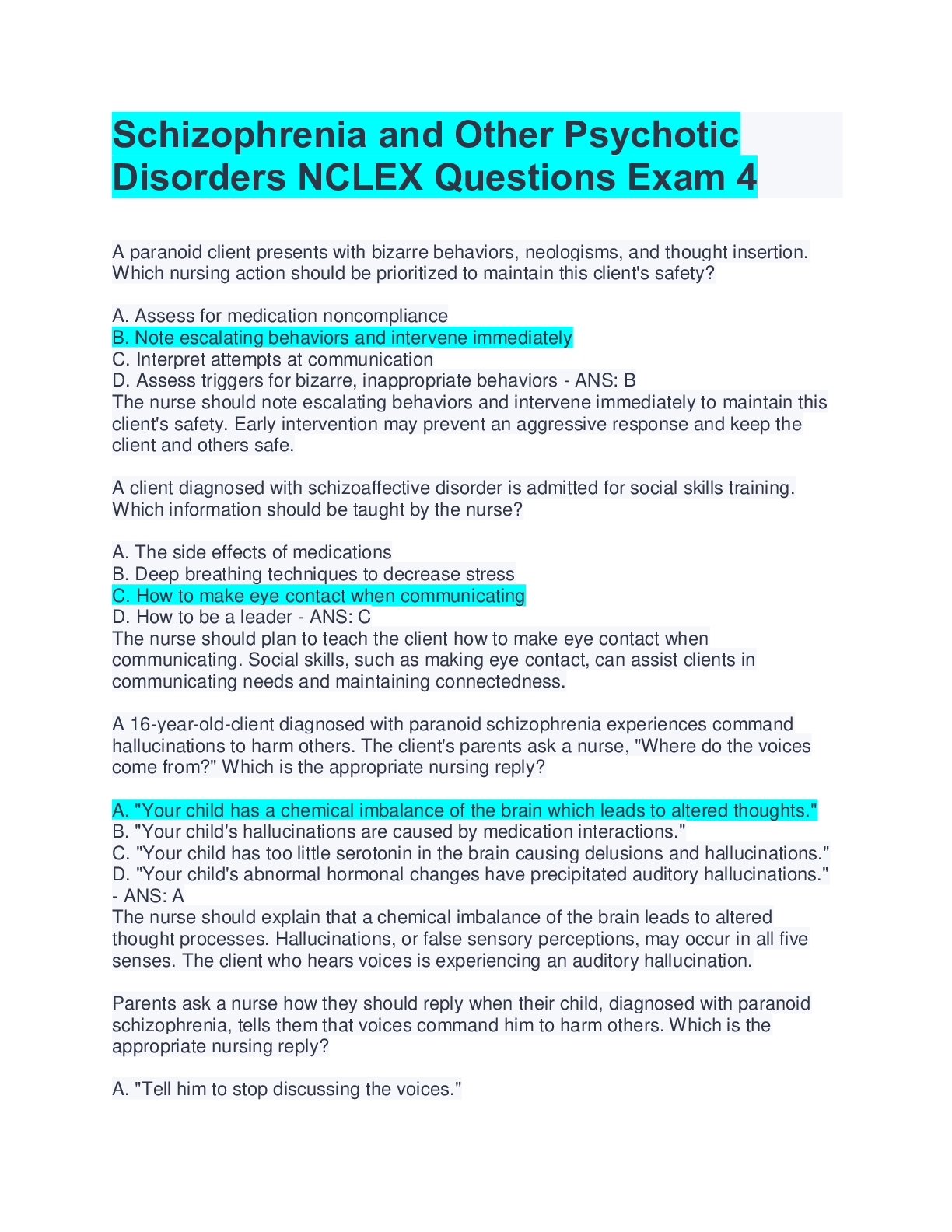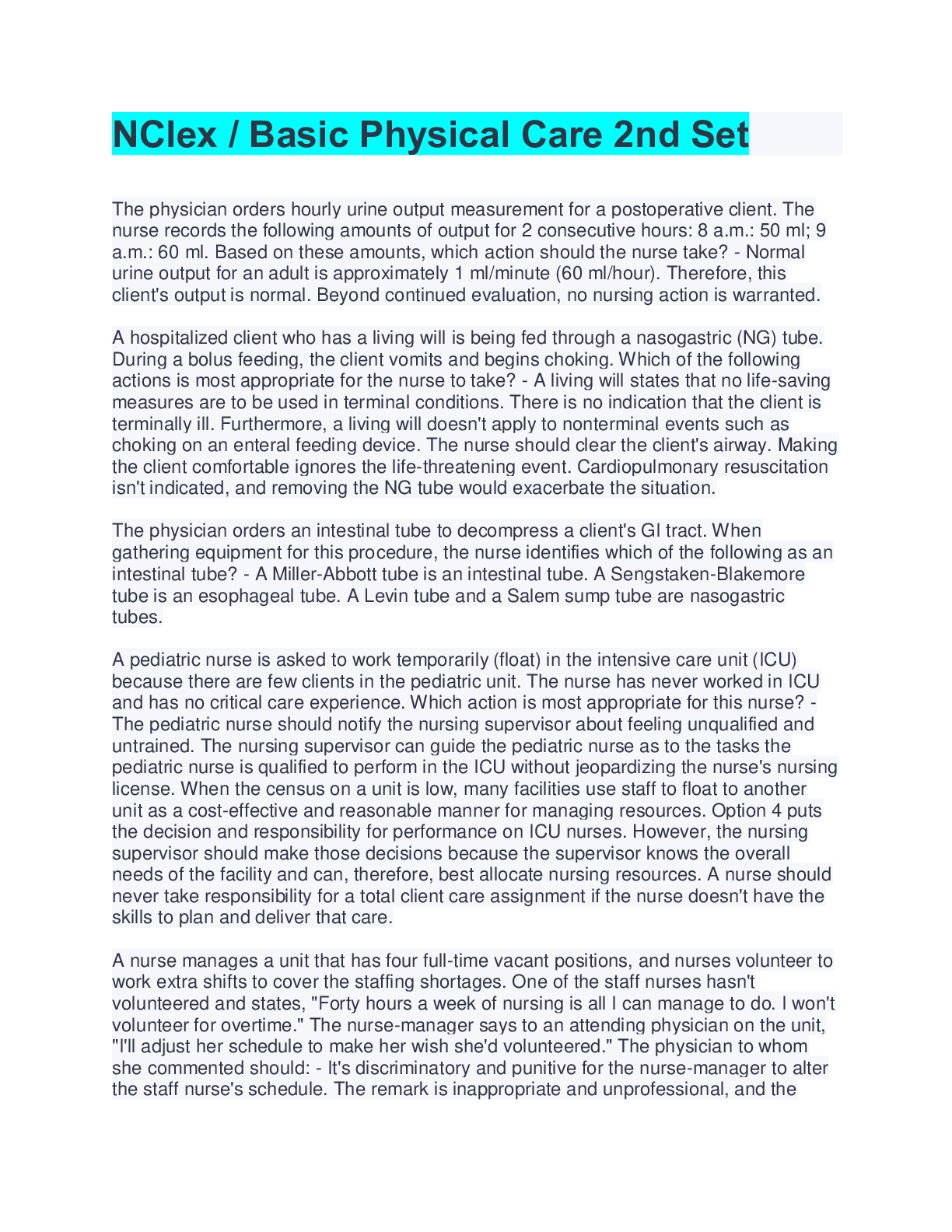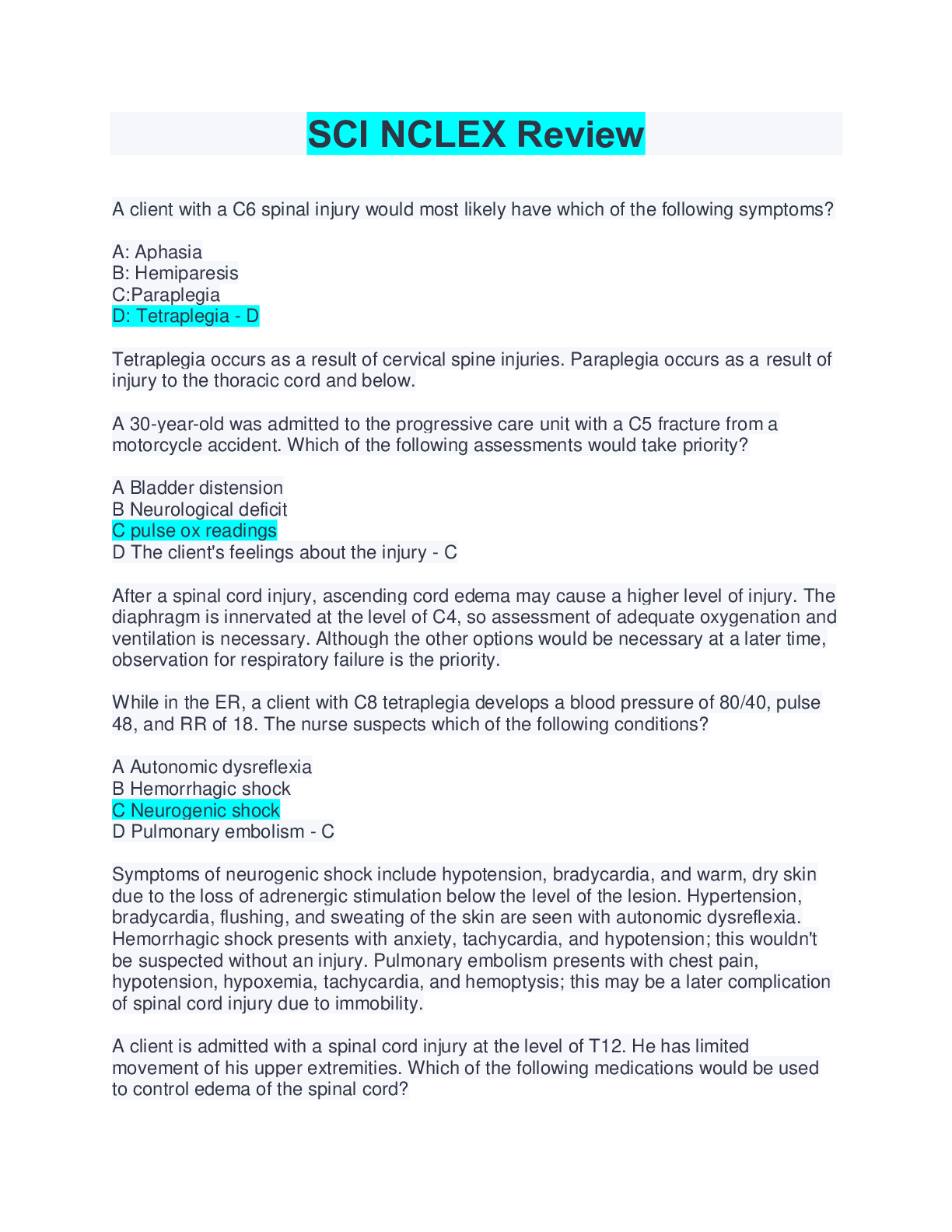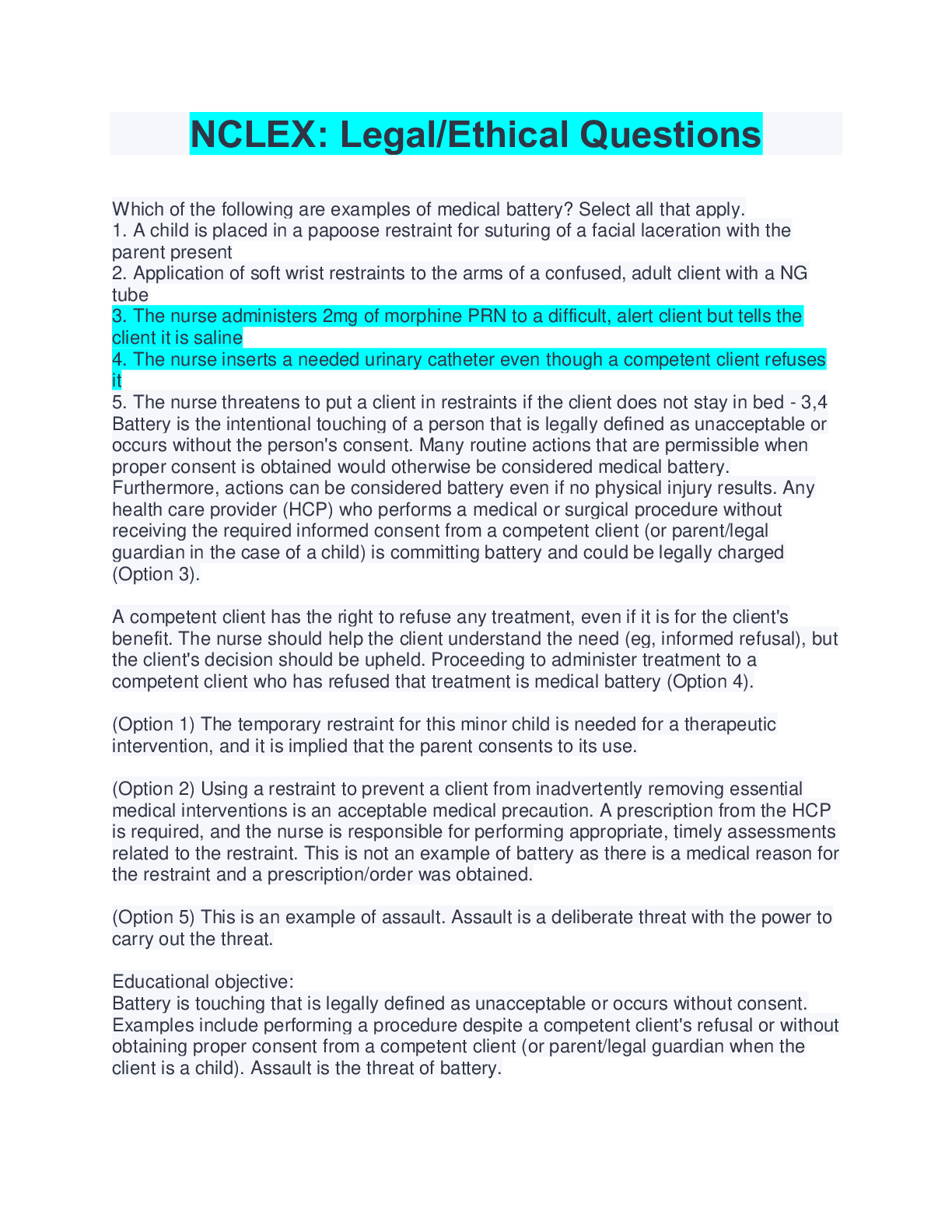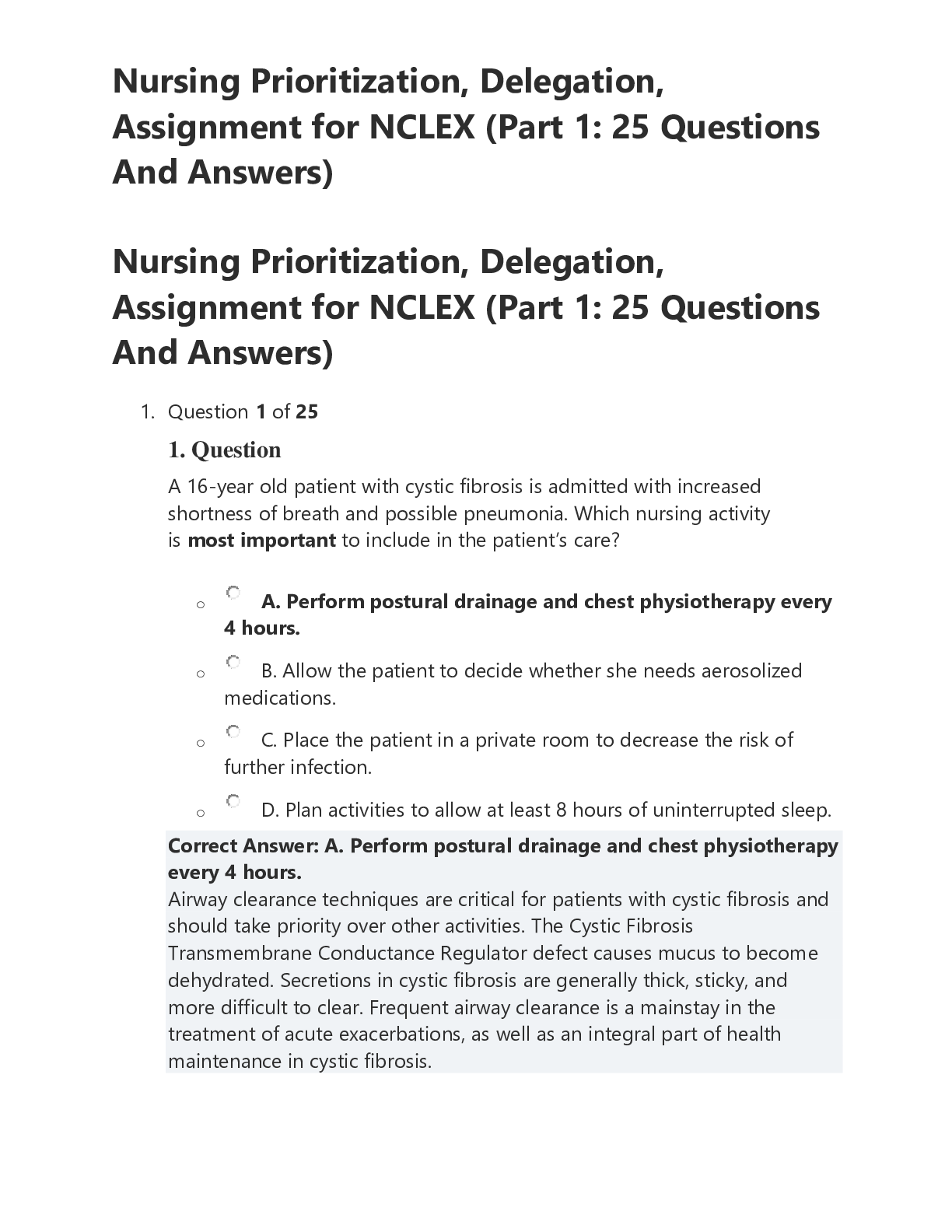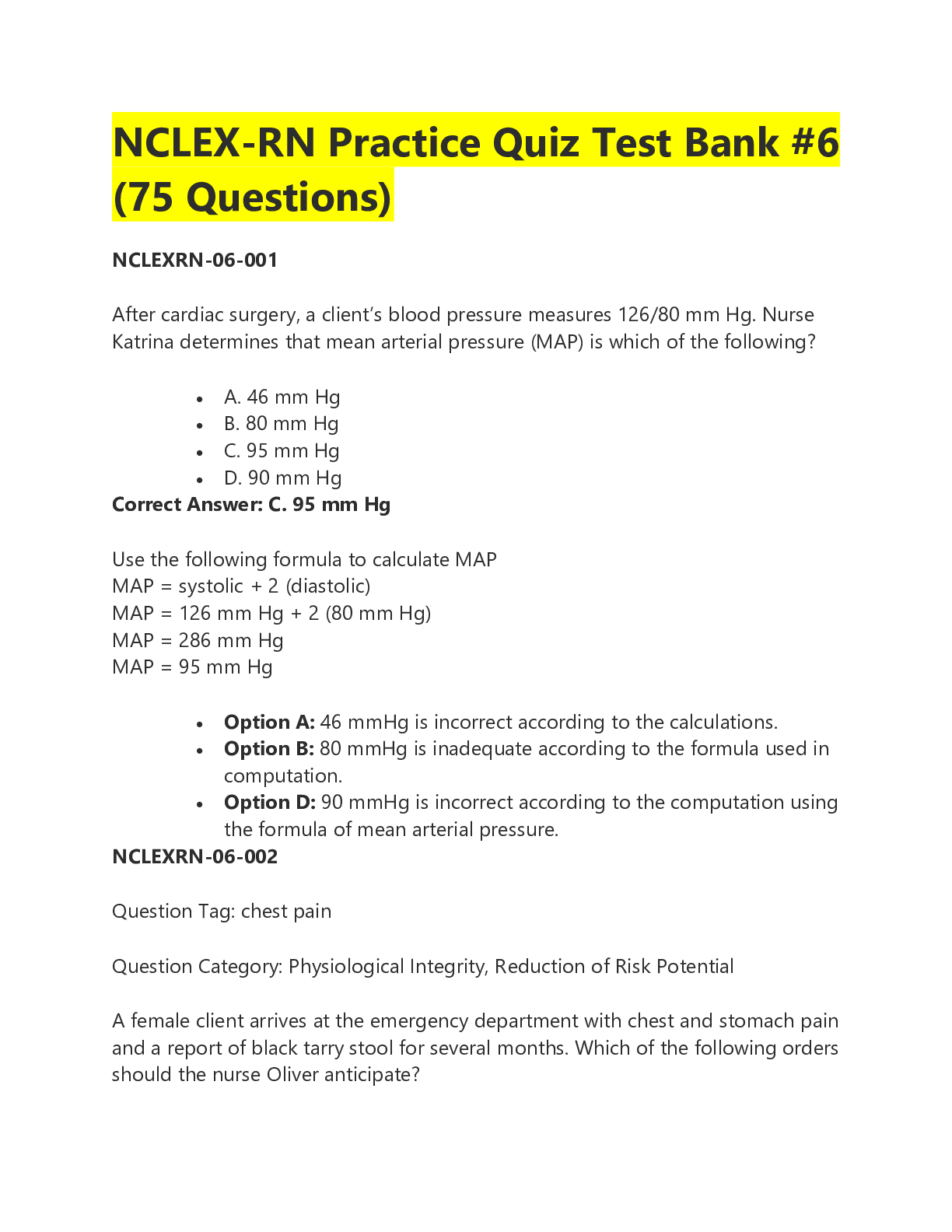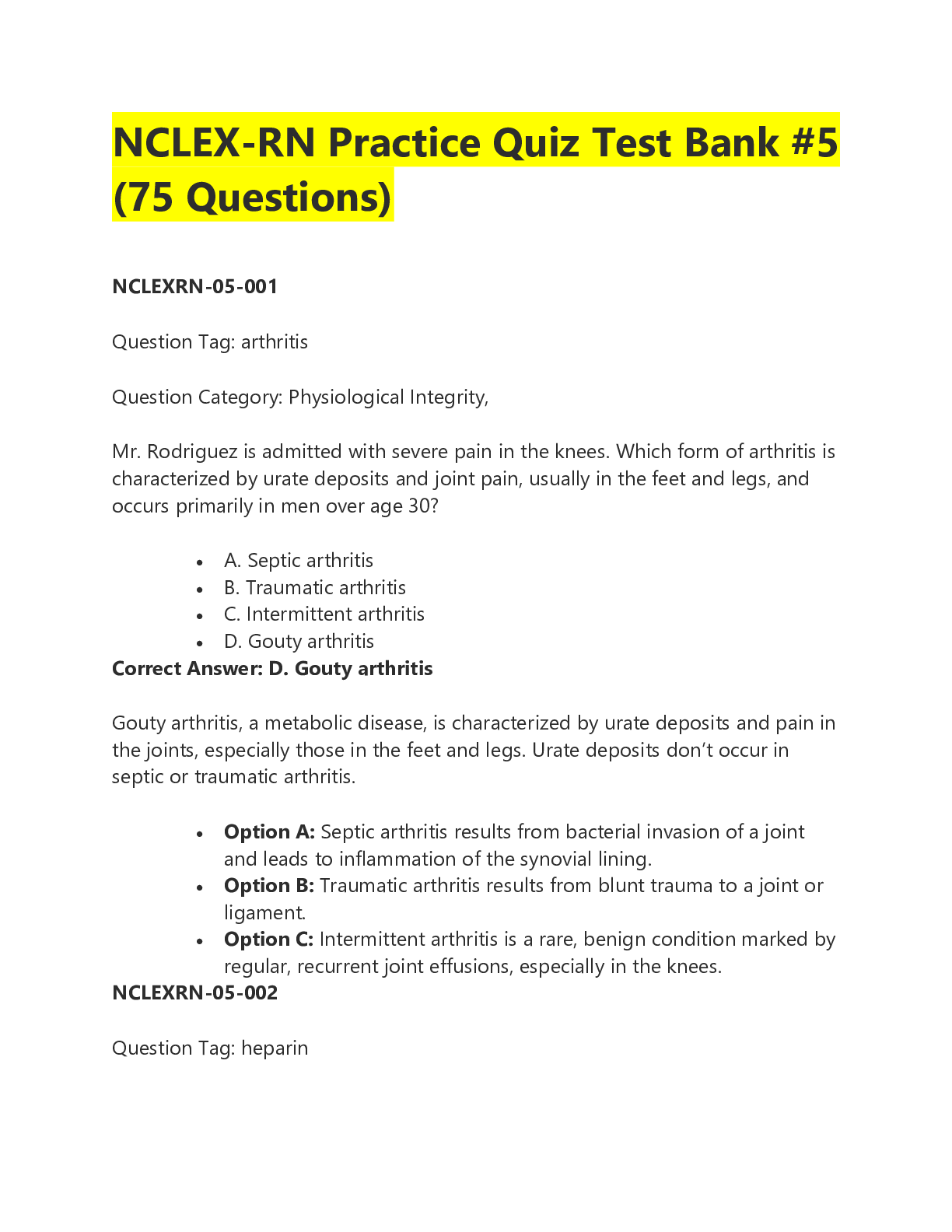*NURSING > NCLEX > Touhy & Jett: Ebersole and Hess’ Gerontological Nursing & Healthy Aging, 5th Edition/Chapter 02: C (All)
Touhy & Jett: Ebersole and Hess’ Gerontological Nursing & Healthy Aging, 5th Edition/Chapter 02: Cross-Cultural Caring and Aging
Document Content and Description Below
Chapter 02: Cross-Cultural Caring and Aging Touhy & Jett: Ebersole and Hess’ Gerontological Nursing & Healthy Aging, 5th Edition MULTIPLE CHOICE 1. Which of the following is a true stateme... nt about differing health belief systems? 2. Which of the following consiNdUerRatSioInsNisGmToBs.t lCikOelMy to be true when working with an interpreter? 3. An older adult who is a traditional Chinese man has a blood pressure of 80/54 mm Hg and refuses to remain in the bed. Which intervention should the nurse use to promote and maintain his health? 4. Which action should the nurse take when addressing older adults? 5. The nurse prepares an older woman, who is Polish, for discharge through an interpreter and notes that she becomes tense during the instructions about elimination. Which intervention should the nurse implement? 6. The nurse plans care for an older African American man who is from Jamaica and resides in New York City. Which should the nurse include in planning care? 7. Which health belief system uses treatments to repair a body part? 8. A nurse is caring for a culturally diverse patient who has missed follow-up appointments with the primary care provider three times over the past year. The patient has a chronic illness that requires periodic monitoring of blood test values. The patient tells the nurse: “You don’t understand—in my culture, we don’t do things like that. I cannot be troubled with worrying about appointments in the future; I deal with each day as it comes.” The nurse understands which of the following about the patient’s culture? ANS: B Time orientation is a culturally constructed factor. Westernized medical care is future oriented. Conflicts between future oriented Westernized medical care and those with a present or past time orientation may arise. Patients are likely to be labeled as noncompliant for failing to keep appointments. PTS: 1 DIF: Understand REF: p. 15-17 TOP: Nursing Process: Planning MSC: Safe, Effective Care Environment 9. A paper on culture and illness would be likely to include the statement that a. culture is the same as ethnicity. b. ethnic groups always share common geographic origin and religion. c. ethnicity involves recognized traditions, symbols, and literature. d. most members of an ethnic group exhibit identical cultural traits. ANS: C Ethnicity is a complex phenomenon that includes traditions, symbols, literature, folklore, food preferences, and dress. It is a shared identity. Ethnicity is more than just culture. It is social differentiation based on culture. Even within ethnic groups, there is considerable diversity. PTS: 1 DIF: Remember REF: p. 12 TOP: Teaching and Learning MSC: Psychosocial Integrity 10. A home care nurse is caring for an older patient from a different culture who is bedbound and high risk for development of a pressure ulcer. The nurse discusses the plan of care with the patient’s daughter, emphasizing the importance of turning every 2 hours, and posts a turning clock on the wall. When the nurse returns later in the week, the turning clock has been removed, and the patient’s daNuUghRteSr IreNpoGrTts Bth.atCsOheMturns her mother occasionally. She states, “I am taking very good care of my mother. You just don’t understand—our ways do not involve doing things on schedules.” The best response by the nurse is: a. “You must follow my guidelines and turn her every 2 hours, or I will not be able to take care of her.” b. “I understand that you value your culture, but culture cannot stop you from providing good care to your mother.” c. ‘I understand that you care very much for your mother. Perhaps caring for her is too much for you.” d. “How can we best work together to provide the best care for your mother?” ANS: D In providing cross-cultural care, it is important that the nurse work with the patient and family and listen carefully and find a way to include the values and beliefs of the patient in the plan of care. PTS: 1 DIF: Analyze REF: p. 15 TOP: Communication and Documentation MSC: Psychosocial Integrity 11. An older patient learns that she has metastatic cancer. The patient states: “I must have angered God.” This is an example of which type of belief? a. Biomedical b. Magicoreligious c. Naturalistic d. Ayurvedic ANS: B Magicoreligious beliefs view illness as caused by actions of a higher authority. Biomedical beliefs view disease as a result of abnormalities in structure and function and disease caused by intrusion of pathogens into the body. Naturalistic beliefs are based on the concepts of balance; health is seen as a sign of balance. Ayurvedic beliefs are of the oldest known paradigm in the naturalistic system; illness is seen as an imbalance. PTS: 1 DIF: Remember REF: p. 17 TOP: Communication and Documentation MSC: Psychosocial Integrity 12. The term health disparity is defined as a. the systematic elimination of the culture of another resulting in decreased wellness. b. differences in health outcomes among groups. c. the difference between an expected incidence and prevalence and that which actually occurs in a comparison population group. d. the existence of more than one group with differing values and perspective. ANS: B Health disparities are defined as differences in health outcomes among groups. Cultural destructiveness is defined as the systematic elimination of the culture of another. Health inequities are defined as the difference between an expected incidence and prevalence and that which actually occurs in a comparison population group. Cultural diversity is defined as the existence of more than one group with differing values and perspective. PTS: 1 DIF: Remember REF: p. 13 TOP: Teaching and Learning MSC: Psychosocial Integrity MULTIPLE RESPONSE NURSINGTB.COM 1. The nurse is assessing an older adult from a culture different than the nurse’s by asking questions from the explanatory model for culturally sensitive assessment. Which question(s) should the nurse ask to follow this model? (Select all that apply.) a. How can we negotiate to solve the problem? b. What treatment can improve your condition? c. Should we try my plan first to see if it helps? d. Can we discuss differences in our plans now? e. How long have you experienced the problem? f. Who, other than me, can make you feel better? ANS: B, E, F Asking about potential therapies is a question from the explanatory model and asks what the individual believes will help clear up the problem. The nurse asks about the duration of the problem as a part of applying the explanatory model. The nurse asks about other disciplines that the individual believes can be therapeutic. This question is based on the LEARN model. PTS: 1 DIF: Apply REF: p. 14 TOP: Nursing Process: Assessment MSC: Health Promotion and Maintenance 2. A nurse caring for older adults must be aware of which consequences of ageism in language? (Select all that apply.) a. Reduced sense of self b. Poor nutritional intake c. Lowered sense of self-competence d. Decreased memory performance ANS: A, C, D Some health professionals demonstrate ageism, in part because providers tend to see many frail, older persons and fewer of those who are healthy and active. Consequences of ageism have been identified as a reduced sense of self, lowered self-esteem, lowered sense of self-competence, and decreased memory performance. Poor nutritional intake has not been identified as a consequence. PTS: 1 DIF: Apply REF: p. 15 TOP: Nursing Process: Assessment MSC: Health Promotion and Maintenance 3. Which factor(s) is/are associated with the provision of culturally competent care? (Select all that apply.) a. Cultural awareness b. Cultural knowledge c. Cultural skills d. Cultural connections e. Knowledge of specific details of traditions and practices of all the different cultures ANS: A, B As nurses move toward cultuNraUl RcoSmIpeNteGnTceB, .thCeyOiMncrease their cultural awareness, knowledge, and skills. Cultural competence means having the skills to put cultural knowledge to use in assessment, communication, negotiation, and intervention. Cultural connections have not been identified as a factor. PTS: 1 DIF: Apply REF: p. 15 TOP: Nursing Process: Assessment MSC: Health Promotion and Maintenance 4. A nurse completes a cultural assessment of an older adult who is being admitted to an assisted living facility. Reasons for completing a cultural assessment include (Select all that apply.) a. culture guides decision making about health, illness, and preventive care. b. culture provides direction for individuals on how to interact during health care encounters. c. culture impacts attitudes toward aging. d. all members of a culture react in the same way in similar situations. e. knowledge of culture eliminates health care disparities. ANS: A, B, C Although knowledge of culture has the potential to optimize care, not all individuals will respond in the same way to a specific situation. Knowledge of an individual’s culture will not eliminate health care disparities. PTS: 1 DIF: Understand REF: p. 15-16 TOP: Teaching and Learning MSC: Psychosocial Integrity 5. A nurse in the ambulatory care setting is preparing to do an interview with a non–English-speaking client. The nurse secures an interpreter. To have the most effective interview, the nurse should do which of the following? (Select all that apply.) a. Look and speak to the interpreter. b. Use technical terminology to ensure accuracy. c. Allow more time for the interview. d. Watch the client’s nonverbal communication. e. Through the interpreter, check whether the client understands the communication. ANS: C, D, E For the most effective interview the nurse should look and speak directly to the client; avoid the use of jargon and technical terminology; observe the client’s nonverbal communications; and clarify understanding by asking the client to state in his or her own words what he or she understood, facilitated by the interpreter. The interview will naturally take longer. PTS: 1 DIF: Remember REF: p. 18-19 TOP: Communication and Documentation MSC: Psychosocial Integrity NURSINGTB.COM [Show More]
Last updated: 1 year ago
Preview 1 out of 7 pages
Instant download

Buy this document to get the full access instantly
Instant Download Access after purchase
Add to cartInstant download
Reviews( 0 )
Document information
Connected school, study & course
About the document
Uploaded On
Aug 08, 2021
Number of pages
7
Written in
Additional information
This document has been written for:
Uploaded
Aug 08, 2021
Downloads
0
Views
51


